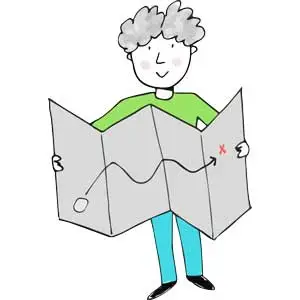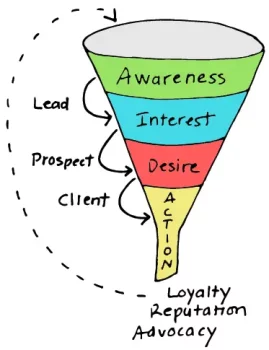What problem does your audience have that you solve?
And how aware are they of the problem?
Understanding where your audience is in your sales funnel helps you nurture them to make a decision that works for them. Basically, your sales funnel is the journey someone takes – starting with being completely new to your business or brand, to becoming a valued customer.
Mapping out your customer’s journey is key to creating an accurate and predictable sales funnel that keeps you on top of leads and revenue coming in.
This includes providing your audience with the tools and resources they need to feel confident in their decision to take action with you. And that includes building trust.
I like to look at the Sales Funnel in 4 simple steps:
- Awareness
- Interest
- Desire
- Action

Think of moving through the 4 steps like waking up hungry for breakfast.
Awareness is when you wake up and realize you’re feeling a little cranky. Maybe the first thing you do is grab a coffee, not realizing that you’re actually hungry. However, by identifying that you are cranky is the first step in identifying a symptom of a problem you have, but at this point, you haven’t done anything about it.
Interest is when you finish that coffee and realize “oh, my stomach is grumbling. Maybe I need to eat”. You’ve now identified the problem and can begin to think about addressing your hunger.
Desire is when you start to look around your fridge for options. Maybe you’re the kind of person who eats the first thing they see, or maybe you’re the person who spends hours looking at the same take-out menu trying to decide what you want. You’re getting excited, trying to decide what is it that will curb your hunger, allowing desire to set in as you analyze all your options.
Action is when you finally decide “I want pancakes!” and start whipping up a delicious plate of fluffy, buttermilk pancakes, dripping in syrup.
At a high-level, this is what the 4 steps of the sales funnel look like.
Now, let’s break each step down so you can start thinking about where your audience may be before choosing your product or service. This will help you understand what you need to do to guide them from the awareness step to the action step in their journey.
1. Awareness
This is the first step of the journey for your customer. They are fresh eyed and bushy tailed as they come across your brand through a Google search, social media, or maybe your blog, a podcast, or a referral.
At the awareness stage, your customer is being introduced to your brand name, and maybe what you can offer them. Usually it’s just a first glance or introduction into their life. In the awareness phase, they don’t usually realize they have a problem that you solve, but are possibly aware of the symptoms.
If you find you’re getting a lot of traffic to your website from organic search results, but your bounce rate is high (meaning they leave your site shortly after arriving there, or only view one page before exiting), this is a great opportunity to start investing in awareness pieces.
Some ways to increase awareness of your brand include:
2. Interest
The second step in the sales funnel is when they start to engage more with your brand, showing you they are interested. Think of this like dating.
Your customer is curious enough that they start following you on social media to see what you’re up to, or read a few blog posts. Maybe they decide to give you their information, such as opting into your email list.
Some ways to help spark interest on your website include:
- The positioning of your call-to-action buttons (CTAs) so they lead your audience to learn more.
- Blog posts with content upgrades – free downloadable or additional value that they need to exchange their contact details for.
- Testimonials and case studies.
This is a great opportunity to nurture their decision to take action with you by producing consistent content, from weekly newsletters to interactive social media activities, to possibly a giveaway or discounts on products or services.
3. Desire
The third step in the sales funnel is about helping your audience decide if you are the right brand for them. At this point they’ve opted into your email list, or possibly booked a call with you to learn more.
Some ways to fuel desire on your website include:
- A lead magnet series, free webinar or workshop that addresses your audience’s pain points.
- Tripwire purchases – small purchases with big value that empower your audience to make a bigger purchase with you in the near future.
- Making it easy for your audience to get in touch with your team, such as a “BOOK A CALL” CTA button.
This value exchange helps them identify that they have a problem and you have a solution for it.
4. Action
The final step in the sales funnel is all about conversion (although making your customers raving fans afterwards is always great for retention and referrals!).
This is the point in the journey where your audience trusts you, feels you are the right product or service to help them solve their problem, and have exchanged their money for your value.
Some ways to support action on your website include:
- Engaging headers, sub-headers, and CTAs.
- A clear process of what happens once they take action.
- An e-commerce platform.
So, where is your audience in your sales funnel?
Now that’s we’ve gone a little deeper into all 4 steps, ask yourself:
- Where might there be gaps in your customer’s journey?
- Where are the opportunities to nurture your audience?
- Maybe you’re thinking to yourself, “Suzanne, I don’t think I know my audience well enough to answer these!”
Don’t worry, everyone has been there. Understanding your audience starts with diving a little deeper into who your audience is by building a custom audience profile (I’ll tell you more about that when we chat!)

Ready to clarify your sales funnel and implement it into the build of your website?
Let’s take a look at what you’ve got and develop a customized plan that takes your website from a few pages on the web, to a nurturing, conversion-oriented platform for your business.n